
As we begin a new academic year, I find myself reflecting on my class routines and seeking ways to reinvigorate my classes and streamline my teaching procedures. One area I have been reflecting on this summer is the class warm-up routine, its purpose, and related strategies.
What is your class warm-up routine? Is it effective? Is it clear? Is it meaningful to your students? Does it represent an efficient use of time and make your ensemble better in the long run?
A solid warm-up should be all of these things. It must truly benefit your ensemble.
Why should directors have a warm-up routine?
A warm-up routine should address a variety of ensemble issues in a predictable and enjoyable manner. The warm-up should:
- Promote student focus
- Contribute to refined individual and ensemble tuning
- Develop listening skills
- Develop new and advanced technique
- Promote enhanced attention to the conductor, and/or
- Allow for the development of ensemble nuance
While a warm-up may not be able to address each of these areas daily, it should focus on one or two of them on any given day. Let’s explore each of these areas in greater focus.
Routine/Focus
Routine is imperative for our students. Students crave routine and always respond positively to a meaningful and predictable warm-up routine.
“Routines help children feel secure and comfortable and help them understand the expectations of the environment. They help reduce the frequency of behavior problems and can result in higher rates of child engagement.” (from Imagine Education Australia, Helping Children Understand Routines)
In Learning to Teach…not just for beginners, author Linda Shalaway explains, “Routines are the backbone of daily classroom life. They facilitate teaching and learning. Routines don’t just make your life easier, they save valuable classroom time. And what’s most important, efficient routines make it easier for students to learn and achieve more.”
We would all certainly advocate for anything likely to make your students feel more secure and designed to save classroom time!
Refined Tuning and Intonation
A strong warm-up should focus on both individual and ensemble tuning. I want my students to think about their own instrument tuning and how they match up with and adjust to the ensemble tuning. For a string orchestra, an important part of my warm-up routine is what I refer to as my “tuning procedure.” This procedure promotes active corporate listening, personal accountability, and eye contact with the conductor.
We begin with a general “A” and everyone tunes their instruments to the best of their ability. I don’t usually do this for younger groups, but there is no harm in everyone giving it a try! When tuning to the general “A” encourage everyone to tune at a dynamic of piano.
Individual Tuning
I believe that tuning is essentially a series of binary questions.
- Is my instrument in tune with the tuning note? (Yes or no)
- If no, is it sharp or flat? If the student isn’t sure, they should try adjusting one way or the other.
- Did my adjustment make it better or worse? (yes or no)
- If worse, try adjusting the adjust the other way.
Group Tuning
- Have everyone tune a unison A. When in tune, they should make eye contact with you.
- On your cue, have the viola, celli, and bass to move to a D (and get that in tune as the violins continue sounding their A). When in tune, they again make eye contact.
- When you are satisfied the low D’s are in tune, have the violins move to D while the violas, celli, and bass continue to sound their D. When you have eye contact from all violins, have the violas, celli, and bass move to the G. When they are making eye contact (and are in tune), have the violins move to G while the violas, celli, and bass continue to sound their G.
- Do the same for the viola and celli C string. Basses should stay on the G for this, along with the violins. When finished with the low C, have everyone stop playing for a second or two.
- Then, go back to a unison A. Invariably, some students will need to adjust. By now, they are really listening.
While you can learn the rest of this tuning procedure here, you get the idea: students are listening to each other, they are making eye contact with you, and the process continues to refine their intonation. In time the whole process can become relatively quick and completely non-verbal.
Listening
As you can see, the tuning procedure promotes listening across the room. The treble parts must listen to the lower voices and vice versa. I find that successful ensembles are aware of other voices at all times. So, the repetition of a consistent warm-up procedure promotes this habit. This is one of the reasons so many warm-up routines utilize a chorale as part of the warm-up routine.
Over the course of time, students really learn what the other voices are doing. On any given day, a different voice may be emphasized as part of the warm-up. It can be a great idea to have one of the voices play their part alone and then have the rest of the ensemble sing their part (learning it by rote). This will transform the way the ensemble hears each other for the rest of rehearsal.
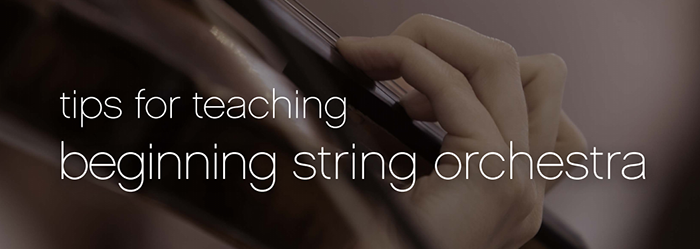 Download a Free Ebook of Beginning Orchestra Tips!
Download a Free Ebook of Beginning Orchestra Tips!
Technique
The warm-up routine is also a wonderful time to introduce and enforce new or more advanced techniques. In a string orchestra setting, I advocate using “cycle form” exercises or etudes. Cycle form was developed by noted pedagog, George Bornoff, and is a magnificent tool for teaching technique in a heterogeneous classroom environment.
I teach these etudes by rote, and once they are in place, they are the perfect vehicle for technique development. The concept is as follows: teach the students a pattern on any string. This can be a scale or interval pattern.
For the purposes of this article, let’s use the first 4 notes of the major scale as an example. (On the G string: A, B, C#, and D.) At the most basic level, each of the pitches will be played 4 times in a quarter note pattern up and down the tetrachord. A more detailed description of this system can be found here with links to handouts, fingerings, and many more resources in the description below the videos.
(sul G string)
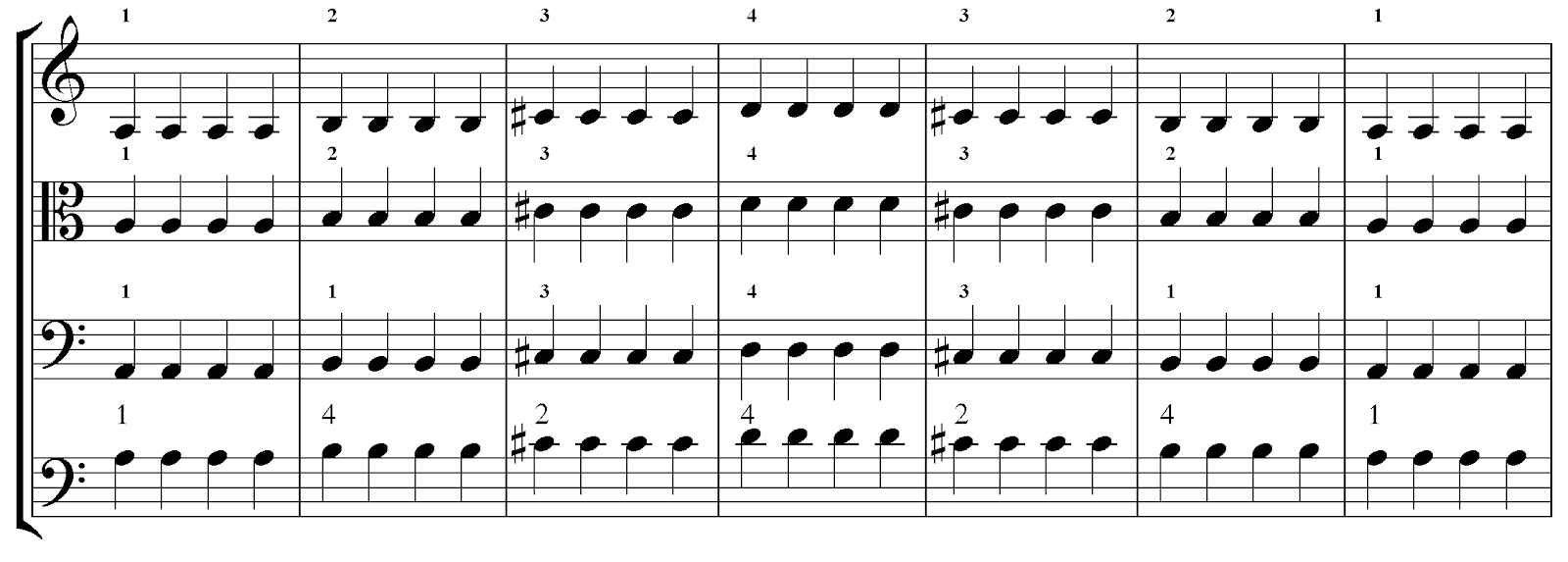
This pattern can be reproduced on each of the open strings in exactly the same way.
(sul C String)
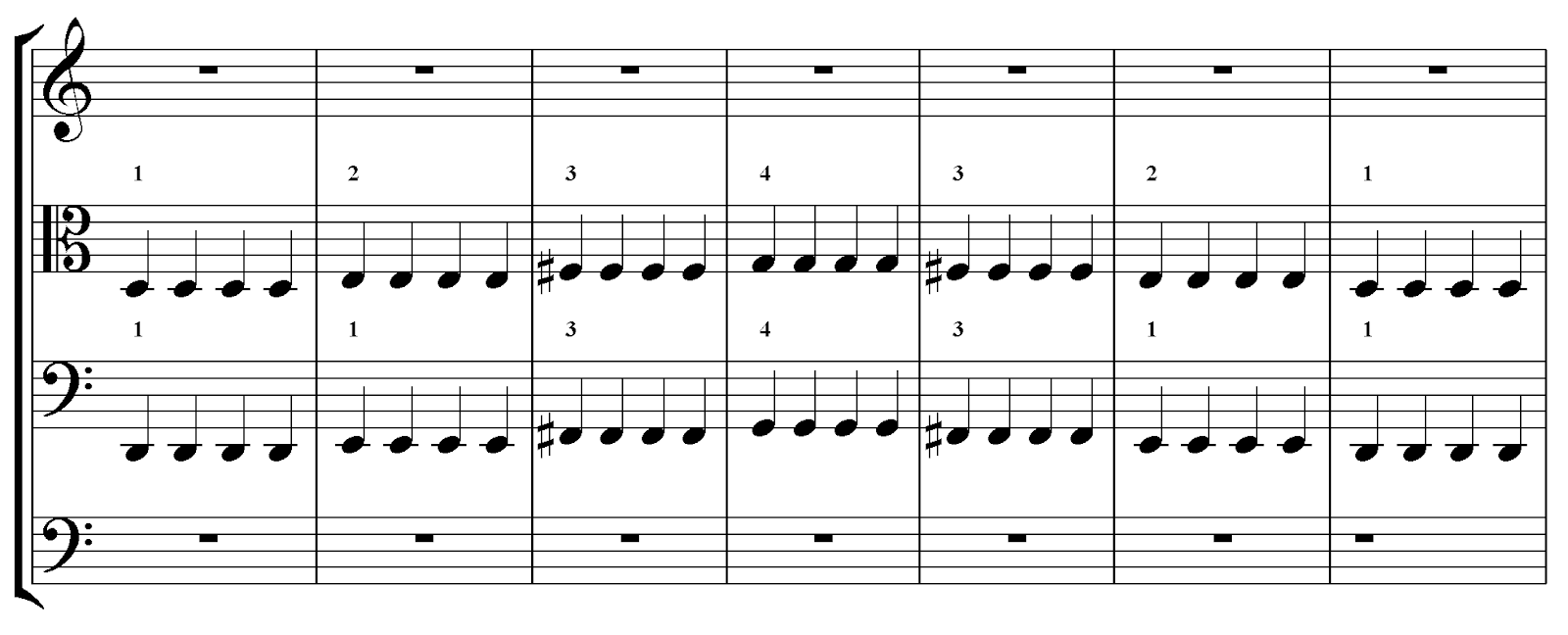
(sul D string)
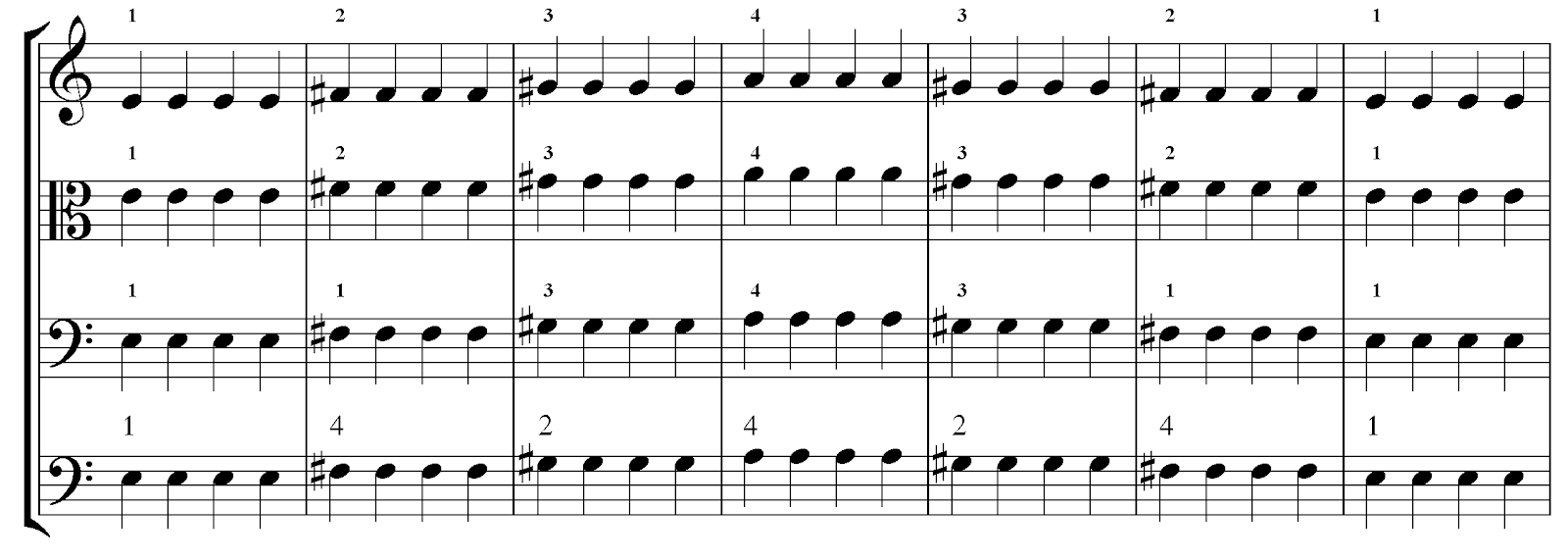
(sul A string)
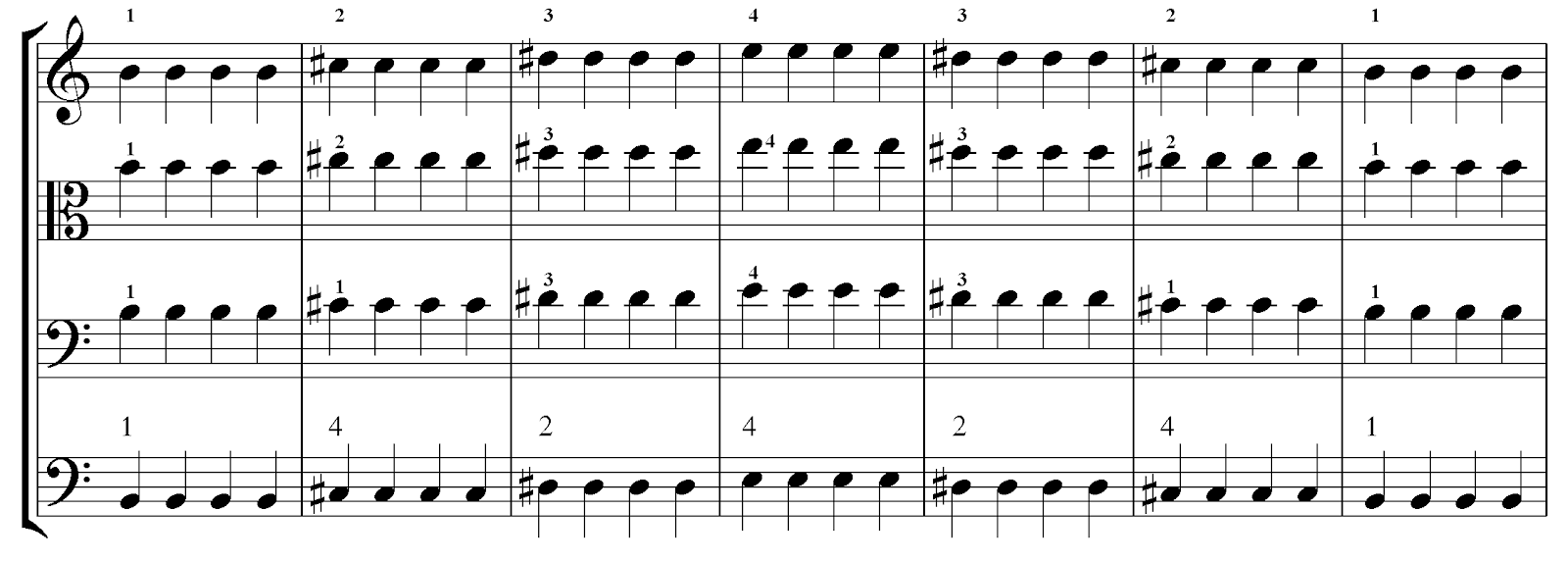
(sul E string)
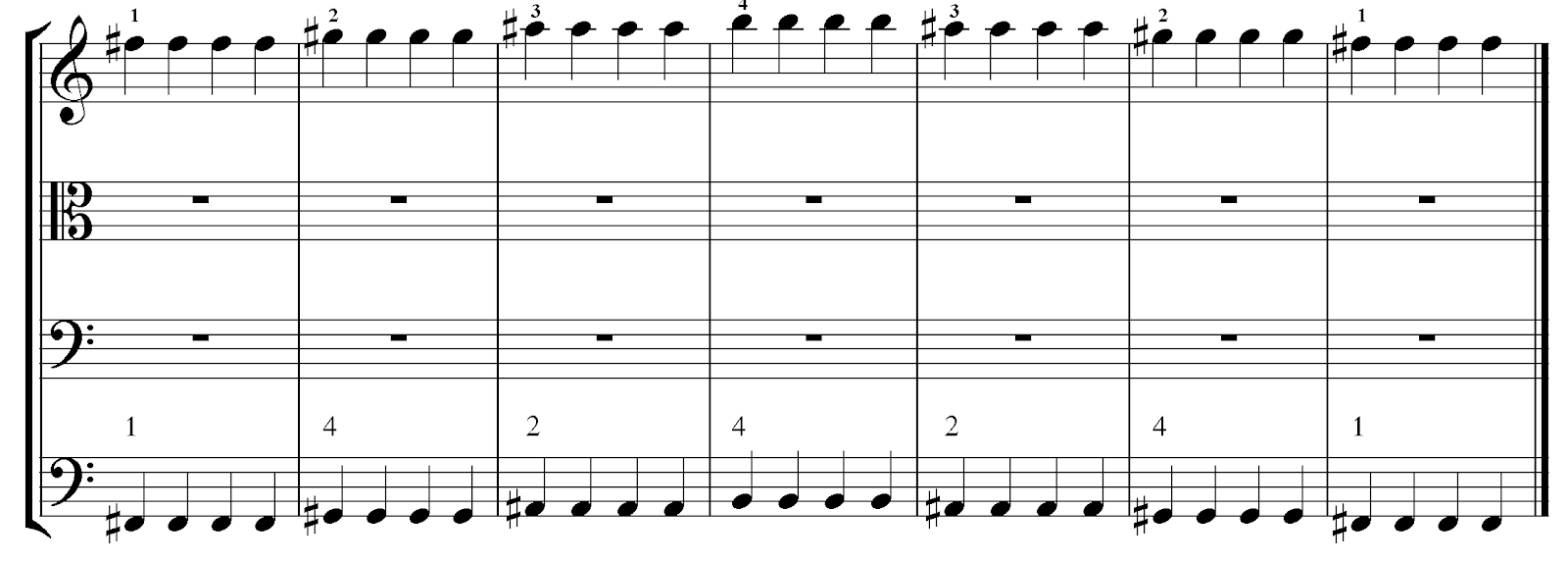
The key point is that each string feels the same to the left hand. It is the same pattern on each string. These patterns can be very simple or more complex. The idea is to establish the cycle form as the standard; then new techniques can be taught or re-enforced through the routine. For example, I teach bowing styles (spiccato, martele, etc) rhythmic bowing patterns (hooked bowing), shifting, upper positions, and other left or right-hand techniques using this strategy.
Nuance
When using a regular chorale as part of the warm-up routine, you might encourage the ensemble to focus on nuance. The ensemble will become fluent when a chorale is repeated regularly over a period of time. With fluency, comes nuance. As the ensemble becomes more and more familiar with the basics of the chorale, you can ask for more nuance such as an emphasis on phrasing, rhythmic push/pull, and dynamic variation. Emphasizing this in warm-ups will facilitate these same discussions in performance repertoire.
Watching
The warm up can also help elevate the attention your students give you as you conduct. As warm-up repertoire is internalized and becomes fluent, you can begin to demonstrate higher expectations of following the stick and utilize more nuance in their conducting. So often, in the performance repertoire, student musicians are focused on reading their part. The warm-up can be a welcome break from the written page and an opportunity to develop other skills including watching the conductor.
What to Use?
How does a director choose solid resources for a warm-up routine? I believe a warm-up book should be clear, comprehensive, and built on the strongest pedagogical foundations. For strings, I use Habits of a Successful String Musician: A Comprehensive Curriculum for Use During Fundamentals Time, by Christopher Selby, Scott Rush, and Rich Moon (GIA Publications). This book presents a differentiated, sequential, and comprehensive method for developing skills that lead to mastery of rhythmic, tonal, and ensemble skills. It provides wonderfully written technique builders that relate to virtually all of the points I have made in this article.
Obviously, there are many warm-up resources available for teachers to select from, and I encourage you to find the one that works for you and your students. These resources can vary in depth, focus, pedagogical underpinning, and even “look.” All of these factors matter and can have a great deal to do with the overall success of your warm-up routine.
Communicate Your Goals
Finally, we must continuously articulate and reinforce the goals of a warm-up routine to our students! They need to know why this time is so important. If we forget to keep our students reminded of this, they will surely become complacent. And, in some ways, reminding them is a good reminder for us as well!
So, as you approach the coming academic year, I encourage you to consider your warm-up routine. Perhaps it is time for some tweaking. Perhaps it is time for a complete overhaul. Or, maybe yours is just right, and you can approach it with a newfound confidence and resolve. No matter which camp you are in, I wish you much success in the coming school year with the finest of musical and ensemble results!